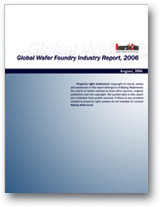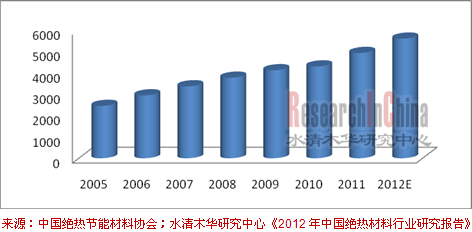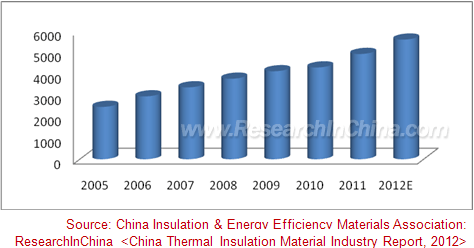|
|
|
报告导航:研究报告—
制造业—材料
|
|
2012年中国绝热材料行业研究报告 |
 |
字数:2.9万 |
页数:62 |
图表数:32 |
|
中文电子版:5500元 |
中文纸版:2750元 |
中文(电子+纸)版:6000元 |
|
英文电子版:1550美元 |
英文纸版:1650美元 |
英文(电子+纸)版:1850美元 |
|
编号:BXM054
|
发布日期:2012-10 |
附件:下载 |
 |
|
|
绝热材料具有良好的隔热、保温性能,既满足了建筑空间或热工设备的热环境,又节约了能源。 近年,中国绝热材料行业已经进入平稳快速发展阶段,到2011年其产量已达到492.8万吨,是2005年的一倍多。随着中国节能减排的推进,特别是建筑节能的纵深发展,预计2012年中国绝热材料产量将超过550万吨。 图:2005-2012年中国绝热材料产量(单位:千吨) 水清木华研究中心《2012年中国绝热材料行业研究报告》在分析中国绝热材料发展现状的同时,重点研究了主要绝热材料产品市场及其重点企业。 绝热材料按材质可分为有机绝热材料、无机绝热材料和金属绝热材料三种。 在有机类绝热材料中,聚苯乙烯泡沫、聚氨酯泡沫一直处于主导地位,但由于前者易燃烧,且燃烧后会释放有毒物质,逐渐被替代;后者虽然保温隔热性能优良但是防火性能较低(B级),曾频频引发火灾。 2011年3月14日,公安部下发《关于进一步明确民用建筑外保温材料消防监督管理有关要求的通知》,要求民用建筑外保温材料须采用燃烧性能为A级的材料,直接限制了聚氨酯泡沫等材料在外墙保温领域的应用,而一些燃烧性能达到A级的有机绝热材料则迅速崛起,如酚醛泡沫塑料(最高燃烧性能可达A级)。 2011年,中国外墙外保温用酚醛泡沫板产量达到51万吨,较2010年增长近8倍。由此也催生了一批新的企业,如莱恩斯、厦门高特、成都龙升科技等。 相比之下,无机绝热材料大多都能满足A级防火要求,目前中国市场最常用的是岩棉、硅酸铝纤维等。在绿色建筑节能材料的倡导下,近年岩棉、玻璃棉等污染性大的无机绝热材料的应用已经受到限制,而硅酸铝纤维以及泡沫混凝土、泡沫玻璃、加气混凝土等新材料逐渐被广泛应用。 硅酸铝纤维又称陶瓷纤维,近年在中国发展迅速,2011年其产量超过50万吨,其中鲁阳股份是中国生产规模最大的陶瓷纤维企业。 泡沫混凝土是一种绿色建筑节能材料,为国内重点推广产品之一,2011年生产企业达到1300余家,产量超过1000万立方米。其中重点企业有河南华泰建材、驻马店市永泰建筑节能材料等。 泡沫玻璃在防火、保温以及价格方面均具有优势,现已在浙江嘉兴、甘肃兰州等地形成规模,代表性企业有浙江振申绝热科技有限公司、浙江德和绝热科技有限公司、兰州鹏飞保温隔热有限公司等。
Thermal insulation materials, with good heat-shielding properties, meet
the thermal environment required by the building space or thermal
equipment, and conserve energy. In recent year, China’s thermal
insulation material industry has entered a stage of steady and rapid
development, with output up to 4.928 million tons in 2011, more than
doubled that in 2005. Following the propulsion of energy conservation
and emissions reduction in China, especially the development of building
energy efficiency in both depth and breadth, China’s thermal insulation
material output in 2012 is expected to outnumber 5.5 million tons. Thermal Insulation Material Output in China, 2005-2012 (Unit: kt)

China
Thermal Insulation Material Industry Report, 2012 of ResearchInChina
makes an analysis on the development of thermal insulation materials in
China, as well as the markets for major thermal insulation material
products and related key enterprises. Thermal insulation
materials, based on the material, can be divided into organic, inorganic
and metal thermal insulation materials. Among organic thermal
insulation materials, polystyrene foam and polyurethane foam have always
occupied the dominant position, however, due to flammability and toxic
substances released by combustion, the former is gradually being
replaced; the latter, despite excellent thermal insulation properties,
has frequently caused fire because of low (B grade) fireproof
performance. On March 14, 2011, The Ministry of Public Security
of the People's Republic of China issued the Notice on Further
Specifying Fire Management Requirements on External Thermal Insulation
Materials for Civil Construction, which demanded A grade combustion
performance of external thermal insulation materials for civil
construction, thus directly restricting applications of polyurethane
foam, etc. in the field of exterior wall insulation, while some organic
insulation materials such as phenolic foam with A grade combustion
performance saw a sharp rise. In 2011, the output of phenolic
foam board for exterior wall insulation in China reached 510,000 tons,
an increase of nearly eight times over 2010, which also spawned a number
of emerging enterprises like Lions Group, Xiamen Goot Advanced Material
Co., Ltd. and Chengdu Longsheng Science & Technology Co., Ltd. In
contrast, the majority of inorganic insulation materials can meet A
grade fire protection requirements; in the current Chinese market, the
most commonly used materials refer to rock wool, aluminum silicate
fiber, etc. Advocated by green energy-saving building materials, rock
wool, glass wool and other polluting inorganic thermal insulation
materials have encountered restrictions, while new materials such as
aluminum silicate fiber, foam concrete, foam glass and aerated concrete
have witnessed wide application. Aluminum silicate fiber, also
known as ceramic fiber, has recently seen rapid development in China,
with output in 2011 exceeding 500,000 tons. Shandong Luyang Share Co.,
Ltd. is the largest ceramic fiber production enterprise in China. As
a kind of green energy-efficient building materials, foam concrete is
deemed as one of the country’s key popularized products. In 2011,
relevant manufacturers amounted to more than 1,300, with output in
excess of 10 million cubic meters, represented by Henan Huatai Building
Materials Development Co., Ltd., Zhumadian City Yongtai Energy-Saving
Building Materials Equipment Limited Company, and so on. Relying
on the advantages in fire prevention, thermal insulation and price,
foam glass has achieved mass production in regions including Jiaxing
(Zhejiang Province) and Lanzhou (Gansu Province), and representative
enterprises include Zhejiang ZhenShen Cold Insulation Technology Co.,
Ltd., Zhejiang Dehe Cold Insulation Technology Co., Ltd. and Lanzhou
Pengfei Heat Preservation Co., Ltd.
第一章 绝热材料介绍
1.1 定义
1.2 分类
1.3 应用领域
第二章 中国绝热材料发展环境
2.1 产业环境
2.2 政策环境
第三章 中国绝热材料发展现状
3.1 行业规模
3.2 供应情况
3.2.1 产量
3.2.2产量构成
3.3需求情况
3.3.1 需求结构
3.3.2 需求预测
3.4 竞争格局
3.4.1 产品竞争
3.4.2 企业竞争
第四章 中国有机绝热材料发展现状
4.1 发展概况
4.2 聚苯乙烯泡沫塑料
4.2.1 简介
4.2.2 应用情况
4.2.3 存在的问题
4.3 硬质聚氨酯泡沫塑料
4.3.1 简介
4.3.2 消费情况
4.3.3 发展前景
4.4 酚醛泡沫塑料
4.4.1 简介
4.4.2 应用情况
4.4.3 发展趋势
第五章 中国无机绝热材料发展现状
5.1 发展概况
5.2 岩棉
5.2.1 简介
5.2.2 发展现状
5.3 硅酸铝纤维
5.3.1 简介
5.3.2 发展现状
5.4 泡沫混凝土
5.4.1 简介
5.4.2 生产情况
5.4.3 应用情况
5.4.4 研发情况
5.5 加气混凝土
5.5.1 简介
5.5.2 发展现状
5.5.3 发展前景
5.6泡沫玻璃
5.6.1 简介
5.6.2 发展现状
5.6.3 发展前景
第六章 中国绝热材料重点企业
6.1联创节能Lecron Energy Saving Materials Co., Ltd.
6.1.1 企业简介
.1.2 经营情况
6.1.3 营收构成
6.1.4 竞争优势
6.1.5 募投项目
6.2 红宝丽Nanjing Hongbaoli Co., Ltd.
6.2.1 企业简介
6.2.2 经营情况
6.2.3 营收构成
6.2.4 毛利率
6.2.5 竞争优势
6.3 万华容威Guangdong Wanhua Rongwei Polyurethanes Co., Ltd.
6.3.1 企业简介
6.3.2 经营情况
6.4 厦门高特高新材料Xiamen Goot® Advanced Material Co., Ltd.
6.4.1 企业简介
6.4.2 经营情况
6.5北京莱恩斯集团Beijing Lions Group
6.5.1 企业简介
6.5.2 经营情况
6.6山东圣泉化工股份有限公司Shandong Shengquan Chemical Co., Ltd.
6.6.1 企业简介
6.6.2 经营情况
6.7 北新集团建材股份有限公司 Beijing New Building Materials Public Limited Company
6.7.1 企业简介
6.7.2 经营情况
6.8 鲁阳股份Shandong Luyang Share Co., Ltd.
6.8.1 企业简介
6.8.2 经营情况
6.8.3 营收构成
6.8.4 毛利率
6.8.5项目进展
6.9星牌建材Beijing Star Building Materials Co.,Ltd.
6.9.1 企业简介
6.9.2 经营情况
6.10上海新型建材岩棉有限公司Shanghai ABM Rock Wool Co., Ltd.
6.10.1 企业简介
6.10.2 经营情况
6.10.3 研发情况
6.11河南华泰建材开发有限公司Henan Huatai Building Materials Development Co., Ltd.
6.11.1 企业简介
6.11.2 经营情况
6.12 驻马店市永泰建筑节能材料设备有限公司Zhumadian City Yongtai Energy-Saving Building Materials Equipment Limited Company
6.12.1 企业简介
6.12.2 经营情况
6.13南京旭建新型建材股份有限公司Nanjing Asahi New Building Materials Co., Ltd.
6.13.1 企业简介
6.13.2 经营情况
6.14浙江开元新型墙体材料有限公司Zhejiang New Century Building Material Co., Ltd.
6.14.1 企业简介
6.14.2 经营情况
6.15上海伊通有限公司Shanghai Ytong Co., Ltd.
6.15.1 企业简介
6.15.2 经营情况
6.16浙江振申绝热科技有限公司Zhejiang Zhenshen Cold Insulation Technology Co., Ltd.
6.16.1 企业简介
6.16.2 经营情况
6.17浙江德和绝热科技有限公司Zhejiang Dehe Cold Insulation Technology Co.,Ltd.
6.17.1 企业简介
6.17.2 经营情况
6.18兰州鹏飞保温隔热有限公司Lanzhou Pengfei Heat Preservation Co., Ltd.
6.18.1 企业简介
6.18.2 经营情况
1. Introduction of Thermal Insulation Materials
1.1 Definition
1.2 Classification
1.3 Applications
2. Development Environment of Thermal Insulation Materials in China
2.1 Industry Environment
2.2 Policy Environment
3. Development of Thermal Insulation Materials in China
3.1 Industry Scale
3.2 Supply
3.2.1 Output
3.2.2 Output Structure
3.3 Demand
3.3.1 Demand Structure
3.3.2 Demand Forecast
3.4 Competitive Landscape
3.4.1 Product Competition
3.4.2 Enterprise Competition
4. Development of Organic Thermal Insulation Materials in China
4.1 Overview
4.2 Polystyrene Foam
4.2.1 Profile
4.2.2 Application
4.2.3 Problems
4.3 Rigid Polyurethane Foam
4.3.1 Profile
4.3.2 Consumption
4.3.3 Development Prospects
4.4 Phenolic Foam
4.4.1 Profile
4.4.2 Application
4.4.3 Development Trends
5. Development of Inorganic Thermal Insulation Materials in China
5.1 Overview
5.2 Rockwool
5.2.1 Profile
5.2.2 Development Status
5.3 Aluminum Silicate Fiber
5.3.1 Profile
5.3.2 Development Status
5.4 Foam Concrete
5.4.1 Profile
5.4.2 Production
5.4.3 Application
5.4.4 R&D
5.5 Aerated Concrete
5.5.1 Profile
5.5.2 Development Status
5.5.3 Development Prospects
5.6 Foam Glass
5.6.1 Profile
5.6.2 Development Status
5.6.3 Development Prospects
6. Key Enterprises in China
6.1 Lecron Energy Saving Materials Co., Ltd.
6.1.1 Profile
6.1.2 Operation
6.1.3 Revenue Structure
6.1.4 Competitive Advantage
6.1.5 Fundraising and Investment Projects
6.2 Nanjing Hongbaoli Co., Ltd.
6.2.1 Profile
6.2.2 Operation
6.2.3 Revenue Structure
6.2.4 Gross Margin
6.2.5 Competitive Advantage
6.3 Guangdong Wanhua Rongwei Polyurethanes Co., Ltd.
6.3.1 Profile
6.3.2 Operation
6.4 Xiamen Goot Advanced Material Co., Ltd.
6.4.1 Profile
6.4.2 Operation
6.5 Beijing Lions Group
6.5.1 Profile
6.5.2 Operation
6.6 Shandong Shengquan Chemical Co Ltd.
6.6.1 Profile
6.6.2 Operation
6.7 Beijing New Building Materials Public Limited Company
6.7.1 Profile
6.7.2 Operation
6.8 Shandong Luyang Share Co., Ltd.
6.8.1 Profile
6.8.2 Operation
6.8.3 Revenue Structure
6.8.4 Gross Margin
6.8.5 Project Progress
6.9 Beijing Star Building Materials Co., Ltd.
6.9.1 Profile
6.9.2 Operation
6.10 Shanghai ABM Rock Wool Co., Ltd.
6.10.1 Profile
6.10.2 Operation
6.10.3 R&D
6.11 Henan Huatai Building Materials Development Co., Ltd.
6.11.1 Profile
6.11.2 Operation
6.12 Zhumadian City Yongtai Energy-Saving Building Materials Equipment Limited Company
6.12.1 Profile
6.12.2 Operation
6.13 Nanjing Asahi-Jiantong New Building Materials Co., Ltd.
6.13.1 Profile
6.13.2 Operation
6.14 Zhejiang New Century Building Material Co., Ltd.
6.14.1 Profile
6.14.2 Operation
6.15 Shanghai Ytong Co., Ltd.
6.15.1 Profile
6.15.2 Operation
6.16 Zhejiang ZhenShen Cold Insulation Technology Co., Ltd.
6.16.1 Profile
6.16.2 Operation
6.17 Zhejiang Dehe Cold Insulation Technology Co., Ltd.
6.17.1 Profile
6.17.2 Operation
6.18 Lanzhou Pengfei Heat Preservation Co., Ltd.
6.18.1 Profile
6.18.2 Operation
表:绝热材料的分类
图:2005-2012年中国绝热材料行业销售收入
图:2005-2012年中国绝热材料产量
表:2010-2011年中国绝热材料(分产品)产量
表:2010-2011年中国复合绝热制品产量
表:中国几种泡沫塑料性能比较
表:XPS在建筑领域的应用
图:2011年美国聚氨酯硬泡消费结构
图:2006-2012年中国聚氨酯硬泡消费量
图:2011年中国聚氨酯硬泡消费结构
表:常用无机绝热材料性能
图:2007-2011年中国硅酸铝纤维产量
表:泡沫混凝土的性能
表:2008-2012年中国泡沫混凝土产量
图:2011年中国泡沫混凝土企业结构
表:2011年中国泡沫混凝土(分应用领域)产量
图:2005-2012年中国加气混凝土产量
图:2009-2011年联创节能营业收入及净利润
表:2008-2011年联创节能硬泡组合聚醚产能、产量、销量
表:2009-2011年联创节能(分产品)主营业务收入)
表:2011年联创节能前五名客户名称、收入贡献及占比
图:2012-2014年联创节能营业收入及净利润
图:2008-2012年红宝丽营业收入及净利润
图:2009-2012年红宝丽硬泡聚醚产能
表:2009-2012年红宝丽(分产品)主营业务收入
表:2009-2011年红宝丽(分地区)营业收入
表:2009-2012年红宝丽(分产品)毛利率
图:2008-2012年鲁阳股份营业收入和净利润
表:2008-2012年鲁阳股份(分产品)主营业务收入
图:2008-2012年鲁阳股份毛利率
表:2009-2012年鲁阳股份(分产品)毛利率
表:YTONG伊通在华历程
Classification of Thermal Insulation Materials
Sales of China Thermal Insulation Material Industry, 2005-2012
Thermal Insulation Material Output in China, 2005-2012
Output of Chinese Thermal Insulation Materials by Products, 2010-2011
Output of Chinese Composite Thermal Insulation Products, 2010-2011
Performance Comparison of Several Foam Plastics in China
XPS Applications in Construction Field
Consumption Structure of American Rigid Polyurethane Foam, 2011
Rigid Polyurethane Foam Consumption in China, 2006-2012
Consumption Structure of Chinese Rigid Polyurethane Foam, 2011
Performance of Common Inorganic Thermal Insulation Materials
Aluminum Silicate Fiber Output in China, 2007-2011
Performance of Foam Concrete
Foam Concrete Output in China, 2008-2012
Foam Concrete Business Structure in China, 2011
Foam Concrete Output in China by Application Fields, 2011
Aerated Concrete Output in China, 2005-2012
Revenue and Net Income of Lecron Energy Saving Materials, 2009-2011
Capacity, Output and Sales Volume of Combined Polyether Rigid Foam of Lecron Energy Saving Materials, 2008-2011
Operating Revenue of Lecron Energy Saving Materials by Products, 2009-2011
Name List and Revenue Contribution of Lecron Energy Saving Materials’ Top 5 Clients, 2011
Revenue and Net Income of Lecron Energy Saving Materials, 2012-2014
Revenue and Net Income of Nanjing Hongbaoli, 2008-2012
Capacity of Polyether Rigid Foam of Nanjing Hongbaoli, 2009-2012
Operating Revenue of Nanjing Hongbaoli by Products, 2009-2012
Revenue Breakdown of Nanjing Hongbaoli by Region, 2009-2011
Gross Margin of Nanjing Hongbaoli by Products, 2009-2012
Revenue and Net Income of Shandong Luyang Share, 2008-2012
Operating Revenue of Shandong Luyang Share by Products, 2008-2012
Gross Margin of Shandong Luyang Share, 2008-2012
Gross Margin of Shandong Luyang Share by Products, 2009-2012
Development Course of Ytong in China
如果这份报告不能满足您的要求,我们还可以为您定制报告,请 留言说明您的详细需求。
|